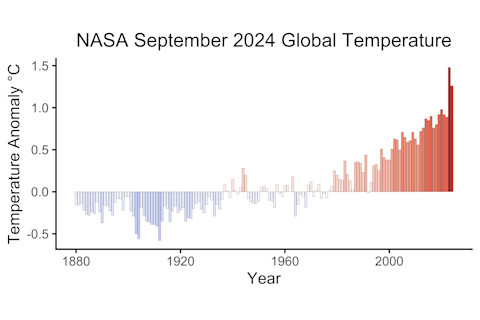After an unprecedented streak of 15 straight months of global heating records, the planet finally caught a tiny break: September did not go down as yet another record-shatterer.
Even so, it was still the second-warmest September in records dating back to 1880. And today, the United Nations released a report saying a huge gap remains between what countries have pledged to do to limit further global heating, and what they've actually done.
Earth's Fever Eases Slightly
After August continued the string of record-warm months, September finally seems to have ushered in a modest change. By NASA's reckoning, Earth's average surface temperature was 1.26 degrees C, or about 2.27 degrees F, above the long-term 1951-1980 average for the month. That's down several tenths of a degree from September of 2023's record-shattering mark.

Here is how September temperatures have varied from the long-term average dating back to the beginning of NASA's record in 1880. As the graph shows, September 2023 was by far the warmest on record. This past September wasn't far behind in second place. (Credit: NASA Climate)
NASA Climate
Today, NOAA released its own analysis, with essentially the same results. NOAA also notes year-to-date, the global average temperature has been the highest such period on record, with North America, South America, Europe, and Africa each ranking first. (Both agencies were delayed in issuing their monthly reports because Hurricane Helene inflicted significant infrastructure damage that affected global data gathering operations located in Asheville, North Carolina.)
Despite the long-hoped-for break in the heat streak, 2024 as a whole is still almost certain to break the record for warmest year.
"With the (belated) September data now in, the updated prediction is that 2024 is almost certain to be a new annual surface temperature record, and possibly by more than 0.1ºC," wrote NASA's Gavin Schmidt on the Bluesky social media platform. He also says there's a 50 percent chance that the average surface temperature for the year will be 1.5 degrees C above preindustrial temperatures.

This is how global temperatures have departed from the preindustrial 1880-1899 average. (The gray shows the uncertainty range.) NASA's prediction for 2024 is shown in green. It is clearly above all previous years. (Credit: NASA's Gavin Schmidt via Bluesky Social)
NASA's Gavin Schmidt via Bluesky Social
That's significant because under the Paris Agreement, almost all nations of the world (including the United States) are committed to limiting human-caused global hearting to no more than 1.5 degrees C. Every tenth of a degree of warming matters. Moreover, surpassing the 1.5 degree threshold would likely bring more frequent heat waves, drought, wildfire, heavy precipitation and flooding. Multiple climatic tipping points could also be triggered, pushing Earth systems from relatively stable states into dramatically different ones, with potentially calamitous consequences.
In fact, we've already experienced a 12-month period during which Earth's average surface temperature stayed above the threshold. It happened July 2023 through June 2024, with a global average temperature of 1.64 degrees C above the 1850-1900 pre-industrial average, as calculated by the European Copernicus Climate Change Service.
But it's too soon to declare the Paris Agreement a failure. Its goals are measured in a decade or more. Over a shorter term of months or even a year or so, temperatures are pushed up and down by natural climatic variations. And, in fact, until very recently temperatures were getting a boost from the El Niño climate phenomenon. El Niño has now faded, and a cooling La Niña phase is likely to develop during the September-November period.
But over the longer run, we're nowhere close to limiting long-term global heating to 1.5 degrees C, according to the U.N. report. In fact, greenhouse gas emissions rose to a new high in 2023 of 57.1 billion tons (expressed in terms of "carbon dioxide equivalent").
Staying below the threshold will require rapid and significant cuts in emissions of heat-trapping greenhouse gases — a 7.5 percent reduction every year until 2035. "Current promises are nowhere near these levels, putting us on track for best-case global warming of 2.6°C this century and necessitating future costly and large-scale removal of carbon dioxide from the atmosphere to bring down the overshoot," says Inger Andersen, Executive Director of the United Nations Environment Program, writing in the foreword to the report.
For the national delegations set to meet in in Azerbaijan next month for the United Nations climate talks, she makes this pointed plea: "No more hot air, please."














